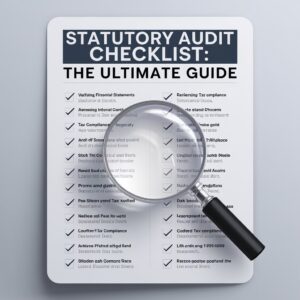Dormant Companies under the Companies Act, 2013
The key objective of revising the Companies Act of 1956 was to simplify the law, making it adaptable to both national and international changes. The revisions aimed to encourage the adoption of global best practices while offering flexibility to respond to evolving business models. One notable introduction in the Companies Act, 2013, is the concept of Dormant Companies, as detailed in Section 455 of the Act.
In simple terms, the word “dormant” refers to something inactive or not currently operational. A dormant company presents a unique opportunity for businesses to either plan for a future project or hold an asset or intellectual property without engaging in significant accounting transactions. Additionally, if a company fails to file its annual returns for two consecutive years, it may also be classified as dormant.
What are Significant Accounting Transactions?
Significant accounting transactions are defined as activities beyond basic procedural transactions. These basic transactions include:
- Payment of fees to the Registrar.
- Payments made to meet legal requirements under the Companies Act or any other law.
- Allotment of shares to comply with the Act.
- Payments made for maintaining the company’s office and records.
The Concept of Dormant Companies
The core idea behind dormant companies is the principle of “invest now, benefit later.” Dormant companies allow businesses to hold assets or intellectual property that can be leveraged in the future. One of the key reasons for doing this is the cost advantage. Restarting a dormant company is often easier and more cost-effective than starting a new company from scratch. Dormant status allows companies to maintain their legal existence without engaging in active operations, meaning they can re-engage with minimal procedural requirements when the time is right.
While a dormant company may not be operational, it continues to exist in the eyes of the law, allowing it to retain its corporate status and, potentially, increase in value over time.

Procedural Formalities for Obtaining Dormant Company Status
Before applying for the status of a dormant company, certain conditions must be met to ensure compliance. Here are the key requirements:
- No Pending Investigations: There must be no ongoing inspection, inquiry, or investigation ordered or conducted against the company, nor any pending prosecution under any law.
- No Outstanding Deposits: The company should not have any outstanding deposits or defaults in payment of amounts or interest.
- No Outstanding Loans: The company must not have any secured or unsecured loans. However, if there are loans, the company may apply for dormant status after obtaining written consent from the lender, which should be attached to Form MSC-1.
- No Management Disputes: There should be no disputes regarding the management or ownership of the company, and a certificate confirming this must be enclosed with Form MSC-1.
- No Pending Statutory Dues: The company should not have any unpaid statutory taxes, dues, or other liabilities to the Central or State Government, local authorities, etc. Additionally, there should be no default in payments to employees or workmen.
- Unlisted Securities: The company’s securities must not be listed on any stock exchange, either within or outside India.
Special Provisions for Dormant Companies
- Minimum Number of Directors:
- Public Company: Minimum 3 directors.
- Private Company: Minimum 2 directors.
- One Person Company (OPC): Minimum 1 director.
- Rotation of Auditors: Not applicable for dormant companies.
- Annual Return for Dormant Company (MSC-3): The company’s financial position, audited by a chartered accountant, must be filed within 30 days from the end of the financial year.
- Return of Allotment and Changes in Directors: To be filed as specified under the Companies Act.
Reactivating a Dormant Company
To move from inactive (dormant) to active status, the following steps must be completed:
- File Form MSC-4: Submit this form to initiate the reactivation process.
- File MSC-3: Ensure that the company’s financial position is filed accordingly.
- Pay the Prescribed Fee: A fee will be required to complete the reactivation process.
Once these steps are completed, the Registrar will issue a certificate in Form MSC-5, confirming the company’s active status. However, if the Registrar believes that the company has been functioning despite applying for dormant status, they may, after an inquiry and giving the company a chance to respond, treat the company as active.
In cases where a dormant company fails to comply with the conditions set in its application, the directors must apply for active company status within seven days.
Conclusion
The concept of dormant companies, introduced in the Companies Act 2013, provides a clear legal framework for companies looking to temporarily suspend operations or hold assets without engaging in significant transactions. This flexibility reflects the adaptability of the updated Companies Act to modern business needs, emphasizing the potential for companies to maintain corporate status while minimizing operational costs during periods of inactivity.
FAQs Related to Dormant Companies
- What is a dormant company under the Companies Act, 2013?
A dormant company refers to a company that is temporarily inactive or inoperative. It may hold assets or intellectual property for future use or may be inactive due to non-filing of annual returns for two consecutive years. Such companies are defined under Section 455 of the Companies Act, 2013. - Why would a company apply for dormant status?
A company may apply for dormant status to hold assets or intellectual property without engaging in significant transactions or to suspend operations for a project intended in the future. Dormant status allows the company to avoid compliance and financial obligations typically required of an active company. - What are the key conditions to apply for dormant status?
Before applying for dormant status, a company must meet the following conditions:
- No ongoing investigations, inquiries, or prosecutions.
- No outstanding loans (or, if any, with lender’s consent).
- No outstanding statutory dues.
- No disputes in management or ownership.
- The company’s securities must not be listed on any stock exchange.
- What is Form MSC-1?
Form MSC-1 is the application form used by a company to obtain dormant company status. It includes declarations about the company’s compliance with the eligibility criteria, and any required supporting documents, such as lender consent or management certificates, must be attached. - How many directors are required for a dormant company?
The minimum number of directors required for a dormant company are as follows:
- Public Company: 3 directors.
- Private Company: 2 directors.
- One Person Company (OPC): 1 director.
- What is a significant accounting transaction for a dormant company?
Significant accounting transactions refer to transactions that go beyond basic procedural activities. These activities include:
- Payment of Registrar fees.
- Statutory payments under the Companies Act or other laws.
- Share allotments and payments for office maintenance.
- How often does a dormant company need to file returns?
A dormant company must file Form MSC-3, which contains the company’s audited financial position, within 30 days from the end of each financial year. - How can a dormant company become active again?
To reactivate a dormant company, the following steps are required:
- File Form MSC-4 to request reactivation.
- Submit the company’s financial position through Form MSC-3.
- Pay the prescribed fee for reactivation. Once these formalities are completed, the Registrar will issue a certificate (Form MSC-5) confirming the company’s active status.
- Can the Registrar reject an application for dormant status?
Yes, if the Registrar believes the company has been conducting business activities despite applying for dormant status, they may conduct an inquiry and provide the company with an opportunity to respond. Based on this, the Registrar may treat the company as active.
10. What happens if a dormant company fails to meet the conditions for dormant status?
If a dormant company fails to comply with the conditions stated in the application or the provisions under the Companies Act, the directors must apply for reactivation within seven days by filing for active company status.
Table of Contents
Toggle


